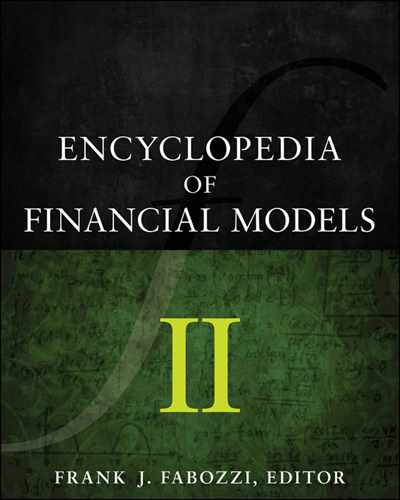Guide to the Encyclopedia of Financial Models
The Encyclopedia of Financial Models provides comprehensive coverage of the field of financial modeling. This reference work consists of three separate volumes and 127 entries. Each entry provides coverage of the selected topic intended to inform a broad spectrum of readers ranging from finance professionals to academicians to students to fiduciaries. To derive the greatest possible benefit from the Encyclopedia of Financial Models, we have provided this guide. It explains how the information within the encyclopedia can be located.
ORGANIZATION
The Encyclopedia of Financial Models is organized to provide maximum ease of use for its readers.
Table of Contents
A complete table of contents for the entire encyclopedia appears in the front of each volume. This list of titles represents topics that have been carefully selected by the editor, Frank J. Fabozzi. The Preface includes a more detailed description of the volumes and the topic categories that the entries are grouped under.
Index
A Subject Index for the entire encyclopedia is located at the end of each volume. The subjects in the index are listed alphabetically and indicate the volume and page number where information on this topic can be found.
Entries
Each entry in the Encyclopedia of Financial Models begins on a new page, so that the reader may quickly locate it. The author’s name and affiliation are displayed at the beginning of the entry. All entries in the encyclopedia are organized according to a standard format, as follows:
- Title and author
- Abstract
- Introduction
- Body
- Key points
- Notes
- References
Abstract
The abstract for each entry gives an overview of the topic, but not necessarily the content of the entry. This is designed to put the topic in the context of the entire Encyclopedia, rather than give an overview of the specific entry content.
Introduction
The text of each entry begins with an introductory section that defines the topic under discussion and summarizes the content. By reading this section, the reader gets a general idea about the content of a specific entry.
Body
The body of each entry explains the purpose, theory, and math behind each model.
Key Points
The key points section provides in bullet point format a review of the materials discussed in each entry. It imparts to the reader the most important issues and concepts discussed.
Notes
The notes provide more detailed information and citations of further readings.
References
The references section lists the publications cited in the entry.
